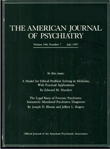Neuroendocrine interrelationships in major depressive disorder
Abstract
The authors administered the thyrotropin-releasing hormone (TRH) stimulation test and the dexamethasone suppression test (DST) to 54 patients who met DSM-III criteria for major depressive disorder and to 19 nondepressed patients. A blunted thyrotropin (TSH) response to TRH injection was noted in 18 depressed patients (33%) but in no nondepressed patients. An escape from dexamethasone suppression was noted in 23 depressed patients (43%) but in only 2 nondepressed patients (11%). The combined sensitivity of the DST and the TRH test in identifying major depressive disorder was 67% with 92% specificity. Only 6 depressed patients (11%) had abnormal responses to both the DST and the TRH test, suggesting that the hypothalamic-pituitary-adrenal axis dysregulation and hypothalamic-pituitary-thyroid axis dysregulation are independent phenomena. These findings support the combined use of these neuroendocrine tests in clinical practice.
Access content
To read the fulltext, please use one of the options below to sign in or purchase access.- Personal login
- Institutional Login
- Sign in via OpenAthens
- Register for access
-
Please login/register if you wish to pair your device and check access availability.
Not a subscriber?
PsychiatryOnline subscription options offer access to the DSM-5 library, books, journals, CME, and patient resources. This all-in-one virtual library provides psychiatrists and mental health professionals with key resources for diagnosis, treatment, research, and professional development.
Need more help? PsychiatryOnline Customer Service may be reached by emailing [email protected] or by calling 800-368-5777 (in the U.S.) or 703-907-7322 (outside the U.S.).



